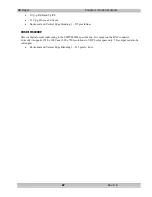
HD Player
Appendix A: TCP/IP Communications
96
Rev. 6.8
Static Assignment
Static assignment allows the user to assign an IP address to a device. Once assigned, it will always retain the
assigned address.
The following sections discuss the structure of IP addresses, and how to assign a static address to the HD Player.
The IP Address
An IP Address is a 32-bit binary number that is used to identify each device on an Ethernet network. This is
represented with four decimal numbers (each in the range 0 to 255) separated by dots, such as:
198.123.34.240.
This is called 'dotted decimal notation'.
Network and Host Identifiers
An IP Address is divided into two parts:
The “network identifier”
The “host identifier”
On a given network, each address must have the same network identifier value but have a unique host identifier.
For example, the following two IP addresses could exist on the same network:
208.132.180.40
208.132.180.55
This assumes that 208.132.180 is the network identifier, and 40 and 55 are the host identifiers.
The above examples are representative of a “Class C” network. Classes are explained in the next section.
Class Names
There are rules governing the valid numbers that can be assigned as network identifiers and host identifiers. The
valid numbers are assigned “classes”.
There are different “classes” of IP addresses that define:
The range of valid addresses
Which parts of the address are used for the network and host identifiers
The most common IP Address classes are:
Class Name
Valid Address
Range Identifier Arrangement
Class A
0.0.0.1 to 127.255.255.254
NNN.HHH.HHH.HHH
Class B
128.0.0.1 to 191.255.255.254
NNN.NNN.HHH.HHH
Class C
192.0.0.1 to 223.255.255.254
NNN.NNN.NNN.HHH
Where:
NNN
= Network identifier
HHH
= Host identifier
















































